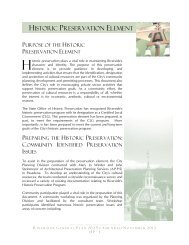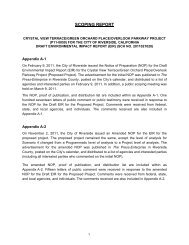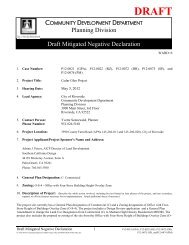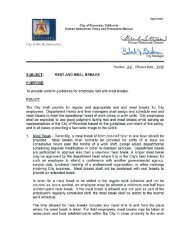Northside - City of Riverside
Northside - City of Riverside
Northside - City of Riverside
Create successful ePaper yourself
Turn your PDF publications into a flip-book with our unique Google optimized e-Paper software.
common wrought iron used in Spanish Revival examples, the balcony posts and<br />
balustrade are crafted in heavy wood.<br />
Colonial Revival<br />
See Residential Architecture 1870-1900 and 1901-1918.<br />
Classical Revival<br />
See Residential Architecture 1870-1900 and 1901-1918.<br />
Minimal Traditional<br />
The Minimal Traditional style rose in popularity in the years before WWII,<br />
dominating large tract-housing development and appearing in significant infill<br />
numbers in established tracts immediately pre- and post-war. The style is loosely<br />
borrowed from the front-gabled, Tudor style sans elaborate detailing and steep<br />
pitch. Features generally include single story plans, close eaves, large chimneys, and<br />
various wall-claddings, including wood, brick, stucco, or stone (McAlester 2000:477).<br />
The trend toward simplicity in the depressed 1930s is apparent in the style, <strong>of</strong> which<br />
examples are scattered throughout the <strong>Northside</strong>, but one fine example designed by<br />
architect Herman O. Ruhnau is extant in the proposed North Hill Historic District at<br />
4465 Randall Road. These simple, unembellished dwellings returned to rival post-<br />
WWII vernacular architecture.<br />
Pre-WWII Vernacular<br />
Emerging from the popular Minimal Traditional style, which loosely borrowed its<br />
design from the Tudor style, vernacular designs were a rather sharp departure from<br />
the traditional form <strong>of</strong> the Eclectic period. The features and details <strong>of</strong> this single-<br />
home resist classification into established architectural styles, but are typically<br />
story<br />
square or rectangular in form with a hipped ro<strong>of</strong>, stuccoed walls, close eaves and<br />
minimal detailing. Pre-WWII Vernacular examples differ little from wartime and<br />
post-war vernacular trends, but are distinct in their dates <strong>of</strong> construction. As<br />
America entered the war in December 1941, vernacular dwellings constructed in the<br />
latter years <strong>of</strong> the 1930s through 1941 are acknowledged as pre-WWII examples,<br />
which are found in the survey area.<br />
114
















